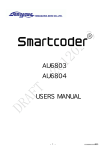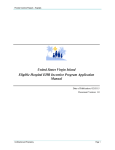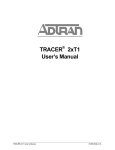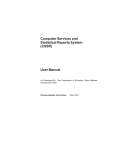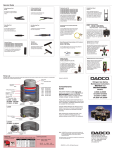Download Capital Asset Reporting for Non-EIS Districts For those
Transcript
Capital Asset Reporting for Non‐EIS Districts For those districts that DO NOT USE EIS, you will be required to use EMISFFE to enter your capital asset information. The steps to complete this are provided below: 1. Log into EMISFFE https://ssdt.esu.k12.oh.us/emisffe/ffeUser/login • EMISFFE requires users to have an account with the OECN IdM - Statewide Identity Management System. If you do not have a username and password already, please contact your ITC. 2. After logging in, it displays the main menu along with your district’s IRN only (not the district name). Click on the “Capital Assets (QC)” link to add your capital asset data. NOTE: If the district entered their capital asset data in EMISFFE last year, it will retain last year’s data. They can select the “DELETE ALL CAPITAL ASSETS” option at the top screen to mass delete what is currently displayed and continue on with step 3 to add capital asset data for the current year. Or they can edit what is currently displayed… please refer to the “Modify An Existing Record” section for further details. ADDING CAPITAL ASSET DATA 3. Click on “NEW CAPITAL ASSETS” to add a record for FY2011. o On the “Capital Assets Code” box, select a code from the drop down list. A listing of available codes and their meanings are on the last page of this document o Enter the prior year balance. You will need to reference either last year’s (FY2010) ending balance or this year’s (FY2011) beginning balance for the amount for this code o Enter total amount of additions (items added) during FY2011 for this asset code o Enter total amount of deductions (items deleted) during FY2011 for this asset code. Click on “CREATE” when finished and repeat step 3 if you need to enter additional capital asset codes. A screenshot of creating a capital asset record is displayed on the next page. DBI Depreciable Capital Assets, Buildings and Building Improvements DBK Depreciable Capital Assets, Books DFE Depreciable Capital Assets, Furniture, Fixtures and Equipment DIN Depreciable Capital Assets, Infrastructure DLI Depreciable Capital Assets, Land Improvements DVE Depreciable Capital Assets, Vehicles LBI Accumulated Depreciation, Buildings and Building Improvements LBK Accumulated Depreciation, Books LFE Accumulated Depreciation, Furniture, Fixtures and Equipment LIN Accumulated Depreciation, Infrastructure LLI Accumulated Depreciation, Land Improvement LVE Accumulated Depreciation, Vehicles NDC Capital Assets not being depreciated, Construction in Progress NDL Capital Assets not being depreciated, Land NOTE: Please refer to the last page of this document if you would like further explanation on the above asset categories. MODIFYING AN EXISTING RECORD • An “Edit” option is available to modify a record that already exists (i.e. prior year’s data). You must first select a record from the “Capital Assets List” by clicking on the “ID #” in order to edit it. • Click on EDIT to edit the existing record. Modifiable fields include the Capital Assets Code, Prior Balance, Additions and Deductions. Click on “Update” to complete the changes. NOTE: You also have the option to DELETE a record. When you are finished creating/updating your capital asset records, you may click on “CAPITAL ASSETS LIST” to review a listing of your capital asset data. NOTE: In most cases, there are no validations done within the FFE application. If bad data is inputted into a field, the record may be saved without errors. You won’t find out about the bad data until you receive the validation reports from your ITC. EXPORTING FILE 4. From the main EMISFFE menu, select “Export Data” to extract data into a flat file format o Select the fiscal year 2011 and reporting period “H – July Financial”. When the reporting period is selected, the record types that are valid for “H” are automatically checkmarked for exporting. Make sure only the “QC Financial Data” record is checked. Then click on Export File to begin extraction process. 5. If the exporting of files is handled by your EMIS Coordinator, please contact him/her requesting to export your Period H “QC Financial Data” from EMISFFE. They should use their normal FTP process to send the file to our EMIS staff and request that it be loaded into EMIS for submission to ODE. • If you will be doing the exporting, save the file to your computer using either the default file name or a name of your choosing. The filename extension must be .SEQ. Once you have • saved the file, you will need to use a FTP utility to transfer the file from your PC to your ITC. Some FTP helpful hints are provided below: i. The SEQ file must be transferred in ASCII mode ii. Do not delete trailing spaces. If using Reflections FTP utility, it automatically deletes trailing spaces from files when they are transferred in ASCII mode. There is a checkbox in Reflections FTP settings that needs to be unchecked to prevent this from happening. CAPITAL ASSET CATEGORIES The following definitions determine the asset category in which an amount should be included for capital asset reporting (found in Chapter 4 of the EMIS User Manual). y Land - A fixed asset account which reflects the acquisition value of the land owned by the school district. This account includes the purchase price and costs such as legal fees, filing and excavation costs, and other associated improvement costs incurred to put the land in condition for its intended use. If land is acquired by gift, the account reflects its appraised value at the time of acquisition. y Land Improvements - A fixed asset account which reflects the acquisition value of permanent improvements, other than buildings, which add value to land. Examples of such improvements are fences, retaining walls, sidewalks, pavements, gutters, tunnels and bridges. If the improvements are purchased or constructed, this account contains the purchase or contract price. If improvements are obtained by gift, it reflects the appraised value at the time of acquisition. y Buildings and Building Improvements - A fixed asset account which reflects the acquisition value of permanent structures, used to house persons and property owned by the school district. If buildings are purchased or constructed, this account includes the purchase or contract price of all permanent buildings and the fixtures attached to and forming a permanent part of such buildings. This account includes all building improvements. If buildings are acquired by gift, the account reflects their appraised value at the time of acquisition. y Furniture, Fixtures, and Equipment - Tangible property of a more or less permanent nature, other than land, buildings, or improvements thereto, which is useful in carrying on operations. Examples are machinery, tools, furniture and furnishings. y Vehicles – Examples are trucks, cars, and buses. y Infrastructure – Example is sewage treatment plant y Books – Examples are textbooks and library books. y Construction in Progress - The cost of construction work undertaken but not yet completed









